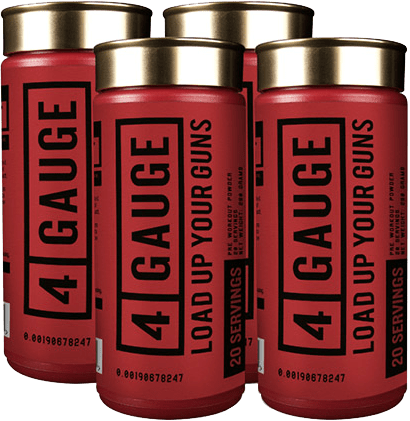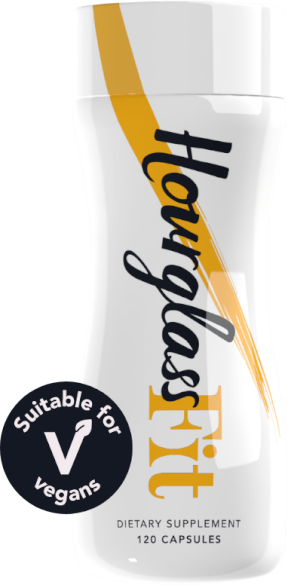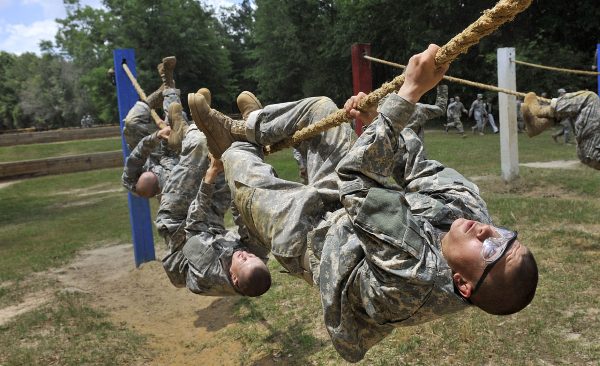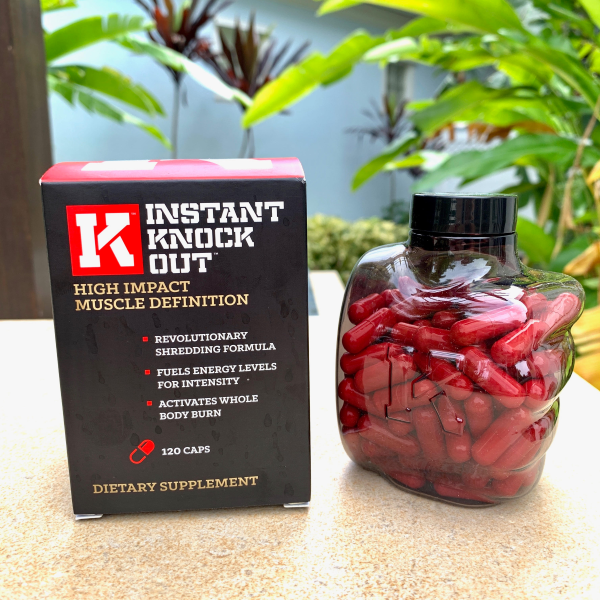Every branch of the military has height and weight requirements that you must fit into before joining. (See a link to each of those at the bottom of the page)
You want to join the military, but you’re overweight.
Thousands of young adults want to join the military every year, but they’re either too big or too small.
You need to lose some weight and get fit to prepare you for boot camp.
Losing weight is a combo of the right diet, right exercises, and supplementation to help you reach your weight loss goals.
To help guide you, OMK partnered with a registered dietitian and a certified personal trainer.
We’ve put together a 30-day plan that tackles both the nutrition portion, as well as the exercise portion, to help you lose that weight fast.
Skip To A Section Below
Step 1: Diet And Nutrition
Step 2: 30-Day Workout Plan
Step 3: Supplements That Will Help You Reach Your Goals Faster
Diet And Nutrition
(Note: The following section was written by Maggy Doherty, a registered dietitian from Dallas, Texas. Click here to learn more about her.)
If you are looking to lose weight or improve your health to qualify for military service, one of the most important aspects is taking a close look at what you are eating and implementing lifestyle changes in your diet to reach your goals.
Nutrition plays a major role in our health, athletic performance, and mental stamina.
On one hand, good nutrition can provide us with energy throughout the day, build lean muscle, optimize health, promote longevity, and lower risk of developing diet-related conditions (like diabetes, heart disease, hypertension, stroke, and some cancers).
Related Article: Can You Join The Military With Diabetes? It’s Possible
On the other hand, poor nutrition can lead to lower energy levels, decreased mental stamina, poor athletic performance, gastrointestinal distress, higher risk for malnutrition, and increased risk of developing those diet-related diseases.
According to the 2015-2020 Dietary Guidelines for America, the main characteristics of a general, healthful diet include:
- An emphasis on fruits, vegetables, whole grains, and fat-free or low-fat milk and milk products;
- Lean meats, poultry, fish, beans, eggs, and nuts;
- Low amounts of saturated fats, trans fats, cholesterol, salt (sodium), and added sugars; and,
- Stays within your daily calorie needs2.
Weight Loss Tips
Maintaining a healthy weight is a balancing act of calories in versus calories out. If you consume more calories than you burn, you should gain weight. If you consume fewer calories than you expend, you should lose weight. If you consume and expend about the same amount of calories, you should maintain weight equilibrium.
Make your weight loss journey a little simple, easier, and realistic by trying one of these tips:
- Replace any calorie-containing drinks (soda, juice, sweet tea) with a non-calorie beverage (water, sparkling water, diet soda).
- Serve yourself smaller portions (half as much as normal).
- Go back for seconds on protein (chicken, fish, beef) and non-starchy vegetables (broccoli, lettuce, mushrooms) before the carbohydrate (potato, pasta, bread).
- Eat every 3-4 hours.
- Include a fruit and/or vegetable at every meal.
- Switch to low or non-fat dairy products.
- Check labels for added sugar, choose “lite” or “diet” versions, or reach for the “whole” version of the product.
- Replace saturated fats (“bad fats” like fatty meats, butter, whole dairy products) with unsaturated fats (“good fats” like fish, avocado, nuts, and plant-based oils).
- Add in an extra 10 minutes of walking per day.
Remember, slow and steady wins the weight loss race! Take control of your life and your weight by incorporating one healthy change per week.
Sample 2,000-calorie diet meal template
Meals (Breakfast, Lunch & Dinner):
- Aim for 450-550 calories each
- Choose 1 of each (as able): 4-6 oz. protein, 1 cup carbohydrate or starchy vegetable, 1 piece fruit, 1 cup non-starchy vegetable, and/or 1 serving fat
Snacks (AM & PM):
- Aim for 200-300 calories each
- Choose 2 total: 2 oz. protein, 1 serving carbohydrate, 1 piece fruit and/or vegetable
Notes:
- Proteins can include: lean meat, fish, poultry, beans or lentils, non-dairy/soy cheese, and egg. Weight for meat is after cooking3.
- Carbohydrates can include: bread, grains, starchy vegetables, or other carbohydrates3.
- Non-starchy vegetables can include: lettuce, kale, cabbage, Brussels sprouts, cauliflower, green beans, tomatoes, etc.
- Fats can include: margarine, salad dressing, mayonnaise, nuts, olives, avocado, oils (coconut, olive oil), etc. Can substitute 1 tablespoon reduced-fat for 1-teaspoon regular3.
| Meal | Menu |
| Breakfast | 1 cup carbohydrate, 4 oz. protein, 1 serving fruit, 1 serving fat |
| AM Snack | 1 serving fruit, 1 serving non-fat dairy |
| Lunch | 1 cup carbohydrate, 6 oz. protein, 1 cup non-starchy vegetable, 1 serving fat |
| PM Snack | 1 serving vegetable, 1 serving fat |
| Dinner | 1 cup carbohydrate, 6 oz. protein, 1 cup non-starchy vegetable, 1 serving fat |
Now let’s plug some real foods in:
| Meal | Menu |
| Breakfast | 1 cup cooked oatmeal, 3 egg whites + 1 whole egg, 1 cup berries |
| AM Snack | 1 cup grapes, 8 oz. non-fat Greek yogurt |
| Lunch | 1 cup cooked brown rice, 6 oz. grilled chicken breast, 1 cup broccoli, 1 tsp. olive oil |
| PM Snack | 1 stalk celery, 2 Tbsp. natural peanut butter |
| Dinner | 1 medium cooked sweet potato, 6 oz. salmon, 1 cup lettuce, 2 Tbsp. reduced-fat salad dressing |
How to adjust caloric intake based on goal
Depending on your physical activity, age, height, weight, and sex, you may require more or less than the standard 2000 calories to reach your goals.
If you try the plan above (or other diet strategy) and you do not lose weight, subtract 250 calories (remove AM snack OR reduce carbohydrate to 2/3 cup at all meals).
If you still do not lose weight, subtract a total of 500 calories (remove BOTH snacks OR reduce carbohydrate to 1/3 cup at all meals).
If you are losing weight too quickly (>2lbs per week) or trying to gain muscle, add 250 calories (add 3rd bedtime snack).
If you need more calories, add another 250 calories with 2 extra servings of fat in your day (ex: 2 Tbsp. of nuts on oatmeal at breakfast and 1/8 avocado on salad at dinner).
If you need a more individualized approach, have a medical condition (i.e. diabetes, heart conditions, etc.), or have detailed questions about your diet, please contact your local Registered Dietitian.
Sample Meal Ideas
Breakfast Ideas:
- Omelet: Vegetable omelet (1 egg + 3 egg whites) with 1 cup sweet potato hash browns and a side of 1 cup mixed berries
- Power oatmeal: 1 cup cooked oatmeal, 1 scoop protein powder (or 3 egg whites), 1-2 Tbsp. chopped nuts or peanut butter, 1 diced banana
- Smoothie: 1 cup liquid (almond milk, non-fat milk, or water), ½ frozen banana, ½ cup frozen fruits or vegetables, and 1 scoop protein powder
Lunch Ideas:
- Turkey Roll Up: 6 oz. lean sliced Turkey breast, ¼ avocado, and spinach rolled up on 1 large tortilla or two 6” tortillas.
- Chopped Salad: 3 cups chopped romaine lettuce, 1 diced hard-boiled egg, ½ cup pinto beans, ½ cup corn, 1 cup chopped green pepper, tomatoes, cucumber, 1 Tbsp. oil/vinegar
- Chipotle Bowl: 6 oz. chicken, 1 cup lettuce, ½ cup cooked brown rice, ½ cup beans, 1 Tbsp. guacamole OR sour cream OR cheese, 2 Tbsp. salsa
Dinner Ideas:
- Stir fry: 1 cup brown rice, 6 oz. shrimp/turkey/chicken, 1-2 cups stir fry veggies (bell peppers, onions, etc.), 1 Tbsp. olive oil, 1 tsp. Sriracha
- Salmon & Veggies: 6 oz. baked salmon with steamed spinach made with 1 tsp. olive oil and 1 medium sweet potato
- Chicken Burrito: 2-3 corn tortillas, ½ cup black beans, 6 oz. diced cooked chicken, 1 Tbsp. guacamole, lettuce, tomato, salsa
Snack Ideas:
- 1 piece of fruit or vegetable with 2 Tbsp. nut butter (ex: celery sticks + almond butter, banana + cashew butter)
- 6 oz. Greek yogurt with 1 cup mixed berries
- Small smoothie
30-Day Workout Plan
(Note: The following section was written by David Sautter, a certified personal trainer with 12 years of experience in the fitness industry. Click here to learn more about him.)
No matter which branch of the military you want to enter, every recruit has to pass a basic fitness test.
While you might be feeling confident, it’s important to know that the days of being able to perform a few push-ups, pull-ups, and a mile run to get into the armed forces are long gone.
The military has gotten with the times and their fitness tests reflect that.
Let’s break down what a basic military fitness test requires and the best type of workout to train for it.
The Military Fitness Test
While there may be some variation depending on the branch of service, here are the basic expectations for a military fitness test, according to Military.com:
| Ranger PFT | Minimum Scores | Recommended Scores |
| Push-ups in 2:00 | 49 in 2:00 | 80 |
| Sit-ups in 2:00 | 59 | 80 |
| Pull-ups | 6 | 12 |
| Two-mile run | 15:12 | Sub 13:00 |
| Five-mile run | 40:00 | 35:00 |
| 16-mile hike w/ 65 lb. pack | 5 hours 20 minutes | 4-5 hours |
| 15-meter swim with gear | P/F | P/F |
Type of Workout
Can you confidently execute 80 push-ups within two minutes? How about a two-mile run in under 13 minutes?
If seeing these requirements is a bit of a reality check, you’re not alone.
Instead of worrying whether or not you’ll be able to pull it off, let’s focus on how you can get into perfect shape to crush the fitness test.
One of the best ways to train for this military fitness test is by combining a full-body resistance training program with high-intensity cardiovascular work.
The idea behind this type of workout is that you’ll challenge all of your major muscle groups at the same time, increasing strength, muscle mass, and endurance.
Best of all, you’ll improve the neuromuscular communication between muscle, tendon, and connective tissue.
In other words, you won’t just be stronger; your body will function better overall.
Resistance Training and Periodization
For the full-body workout, you will hit each major muscle group twice per week using weight-based resistance training.
You’ll also cycle through four stages of fitness benefits.
In this way, you’ll achieve all of these benefits if you use this workout program consistently.
As you move from stage to stage, you will increase the number of sets and how much weight you use while decreasing the number of repetitions.
- Endurance: Refers to the stamina of your muscles. Use 50% to 60% of your one-repetition maximum (1RM) or the maximum amount of weight you can lift one time.
- Muscle Growth: Size and leanness of your muscles. Use 60% to 70% of your 1RM.
- Strength: How much you can safely lift, pull, or move. Use 70% to 80% of your 1RM.
- Power: Amount of raw force you can generate. Use 90% to 100% of your 1RM.
High-Intensity vs. Low-Intensity Cardiovascular Training
Your cardiovascular exercise will be a mixture of high-intensity and low-intensity cardio.
Both have been shown to promote weight loss, but high intensity is better at improving your endurance, maximum target heart rates, and oxygen capacity.
Be sure to warm up for 10 to 15 minutes and stretch before every cardio session and weight training workout.
Week One:
Monday: Full-Body Workout (Endurance)
- Barbell Back Squat: 2 sets of 12 to 15 repetitions
- Lat Pulldown: 2 x 12 – 15
- Lying Leg Curl: 2 x 12 – 15
- Dumbbell Bench Press: 2 x 12 – 15
- Hanging Knee Lift: 3 x 8 – 10
Tuesday: Cardiovascular Training
- Push-Ups: 5
- Jump Squats: 10
- Pull-Ups: 5
- Side Lunges: 10
- Mountain Climbers: 20
- Sprints: 5 seconds
Wednesday: Rest Day
- Spend the day focusing on your nutritional goals including calorie counting, meal planning, and meal preparation.
- Strive to get seven to nine hours of sleep.
- Drink plenty of water: the more active you are, the more water you need.
Thursday: Full-Body Workout (Endurance)
- Barbell Bench Press: 2 sets of 12 to 15 repetitions
- Romanian Deadlift: 2 x 12 – 15
- Pull-Ups: 2 x 5 – 10
- Dumbbell Sumo Squat: 2 x 12 – 15
- Woodchopper: 3 x 8 – 10
Friday: Cardiovascular Training
Spend 30 to 45 minutes performing a cardiovascular exercise of your choice. Here are some ideas:
- Jogging / Running
- Biking
- Swimming
- Hiking
- Yoga
Saturday: Rest Day
- Spend the day focusing on your nutritional goals including calorie counting, meal planning, and meal preparation.
- Strive to get seven to nine hours of sleep.
- Drink plenty of water: the more active you are, the more water you need.
Sunday: Cardiovascular Training
- Begin with a 10 to 15-minute warm-up and stretching session
- Jog / Sprint Combos: For this exercise, you’ll base everything in one-minute increments
- Jog for 55 seconds then sprint for 5 seconds.
- Repeat
Week Two:
Monday: Full-Body Workout (Muscle Growth)
- Barbell Back Squat: 3 sets of 10 to 12 repetitions
- Lat Pulldown: 3 x 10 – 12
- Lying Leg Curl: 3 x 10 – 12
- Dumbbell Bench Press: 3 x 10 – 12
- Hanging Knee Lift: 3 x 8 – 10
Tuesday: Cardiovascular Training
- Push-Ups: 6
- Jump Squats: 10
- Pull-Ups: 6
- Side Lunges: 10
- Mountain Climbers: 20
- Sprints: 7 seconds
Wednesday: Rest Day
- Spend the day focusing on your nutritional goals including calorie counting, meal planning, and meal preparation.
- Strive to get seven to nine hours of sleep.
- Drink plenty of water: the more active you are, the more water you need.
Thursday: Full-Body Workout (Muscle Growth)
- Barbell Bench Press: 3 sets of 10 to 12 repetitions
- Romanian Deadlift: 3 x 10 – 12
- Pull-Ups: 3 x 10 – 12
- Dumbbell Sumo Squat: 3 x 10 – 12
- Woodchopper: 3 x 8 – 10
Friday: Cardiovascular Training
Spend 30 to 45 minutes performing a cardiovascular exercise of your choice. Here are some ideas:
- Jogging / Running
- Biking
- Swimming
- Hiking
- Yoga
Saturday: Rest Day
- Spend the day focusing on your nutritional goals including calorie counting, meal planning, and meal preparation.
- Strive to get seven to nine hours of sleep.
- Drink plenty of water: the more active you are, the more water you need.
Sunday: Cardiovascular Training
- Begin with a 10 to 15-minute warm-up and stretching session
- Jog / Sprint Combos: For this exercise, you’ll base everything in one-minute increments
- Jog for 55 seconds then sprint for 5 seconds.
- Repeat
Week Three:
Monday: Full-Body Workout (Strength)
- Barbell Back Squat: 4 sets of 6 to 8 repetitions
- Lat Pulldown: 4 x 6 – 8
- Lying Leg Curl: 4 x 6 – 8
- Dumbbell Bench Press: 4 x 6 – 8
- Hanging Knee Lift: 4 x 6 – 8
Tuesday: Cardiovascular Training
- Push-Ups: 7
- Jump Squats: 10
- Pull-Ups: 7
- Side Lunges: 10
- Mountain Climbers: 20
- Sprints: 9 seconds
Wednesday: Rest Day
- Spend the day focusing on your nutritional goals including calorie counting, meal planning, and meal preparation.
- Strive to get seven to nine hours of sleep.
- Drink plenty of water: the more active you are, the more water you need.
Thursday: Full-Body Workout (Strength)
- Barbell Bench Press: 4 sets of 6 to 8 repetitions
- Romanian Deadlift: 4 x 6 – 8
- Pull-Ups: 4 x 6 – 8
- Dumbbell Sumo Squat: 4 x 6 – 8
- Woodchopper: 4 x 6 – 8
Friday: Cardiovascular Training
Spend 30 to 45 minutes performing a cardiovascular exercise of your choice. Here are some ideas:
- Jogging / Running
- Biking
- Swimming
- Hiking
- Yoga
Saturday: Rest Day
- Spend the day focusing on your nutritional goals including calorie counting, meal planning, and meal preparation.
- Strive to get seven to nine hours of sleep.
- Drink plenty of water: the more active you are, the more water you need.
Sunday: Cardiovascular Training
- Begin with a 10 to 15-minute warm-up and stretching session
- Jog / Sprint Combos: For this exercise, you’ll base everything in one-minute increments
- Jog for 55 seconds then sprint for 5 seconds.
- Repeat
Week Four:
Monday: Full-Body Workout (Power)
- Barbell Back Squat: 5 sets of 3 to 5 repetitions
- Lat Pulldown: 5 x 3 – 5
- Lying Leg Curl: 5 x 3 – 5
- Dumbbell Bench Press: 5 x 3 – 5
- Hanging Knee Lift: 5 x 3 – 5
Tuesday: Cardiovascular Training
- Push-Ups: 8
- Jump Squats: 10
- Pull-Ups: 8
- Side Lunges: 10
- Mountain Climbers: 20
- Sprints: 10 seconds
Wednesday: Rest Day
- Spend the day focusing on your nutritional goals including calorie counting, meal planning, and meal preparation.
- Strive to get seven to nine hours of sleep.
- Drink plenty of water: the more active you are, the more water you need.
Thursday: Full-Body Workout (Power)
- Barbell Bench Press: 5 sets of 3 to 5 repetitions
- Romanian Deadlift: 5 x 3 – 5
- Pull-Ups: 5 x 3 – 5
- Dumbbell Sumo Squat: 5 x 3 – 5
- Woodchopper: 5 x 3 – 5
Friday: Cardiovascular Training
Spend 30 to 45 minutes performing a cardiovascular exercise of your choice. Here are some ideas:
- Jogging / Running
- Biking
- Swimming
- Hiking
- Yoga
Saturday: Rest Day
- Spend the day focusing on your nutritional goals including calorie counting, meal planning, and meal preparation.
- Strive to get seven to nine hours of sleep.
- Drink plenty of water: the more active you are, the more water you need.
Sunday: Cardiovascular Training
- Begin with a 10 to 15-minute warm-up and stretching session
- Jog / Sprint Combos: For this exercise, you’ll base everything in one-minute increments
- Jog for 55 seconds then sprint for 5 seconds.
- Repeat
Supplements To Help Aid Your Weight Loss Goals
When it comes to losing weight, nothing trumps diet and exercise.
With that said, there are some supplements out there that can help to speed up the process.
OMK did some research and identified the following supplements as being ideal for aiding in your weight loss goals.
Supplements For Men
Fat Burner Choice #1 – Instant Knockout
Developed by a company called Roar Ambition, Instant Knockout is a ‘revolutionary shredding formula’ that claims to activate whole-body burn.
It’s actually a particularly useful supplement for belly fat, as I’ve personally used it for that purpose.
Originally developed for MMA fighters and professional boxers, their formula is reportedly based on scientific research and intended to:
- Help burn stubborn fat deposits
- Increase metabolism
- Reduce hunger cravings
- Increase energy levels
Instant Knockout apparently works by boosting your metabolic rate, helping reduce your appetite, and fueling energy levels.
Click Here to read our full review of Instant Knockout.
Fat Burner Choice #2 – Hunter Burn
Hunter Burn is a premium performance dietary supplement that claims to burn fat, beat hunger, and help you build muscle.
And they have the proof to back up those claims.
Made up of a proprietary blend of ingredients that includes extracts like Konjac root, Cayenne Pepper, and Matcha Green Tea, Hunter Burn is clinically dosed to help you safely melt away stubborn fat.
While we were a bit skeptical when we initially came across it, the reviews put all of those worries to rest.
Visit the official Hunter Burn website here: https://www.hunterevolve.com/en-us/hunter-burn
4 Gauge Pre Workout

Sometimes, it’s just tough to drag your butt to the gym.
It’s been said that getting there is half the battle, and I can tell you from experience, there’s more than a hint of truth to that.
This is where 4 Gauge pre workout comes in…
Made up of a powerful ingredients list that includes 150 mg of caffeine, 200 mg of L-Theanine, and 6,000 mg of L-Citrulline, 4 Gauge will get you pumped up and ready to tackle any workout.
In fact, I’ve actually been personally taking it for the last 2 months now and can attest to its effectiveness.
Visit the official 4 Gauge website here: www.4gauge.com
Supplements For Women
Hourglass Fit Female Fat Burner

Hourglass Fit is a fat-burning pill that was designed specifically for women, made of powerful and natural ingredients, and built to enable women to reach their fat-burning goals.
The key differentiation between Hourglass Fit and some of the more traditional weight loss supplements is that it contains both fat-burning ingredients and appetite suppressants.
Like Hunter Burn, it also contains an array of clinically proven ingredients like Green Coffee and Glucomannan, as well as 8 others.
If you’re a female and you’re looking for something to aid in your weight loss goals, Hourglass Fit is it.
Click Here for our review of Hourglass Fit.
Visit the official Hourglass Fit site here: www.HourglassFit.com
Military Height And Weight Requirements
Army Height And Weight Requirements
Air Force Height And Weight Requirements
Navy Height And Weight Requirements
Marine Corps Height And Weight Requirements
Coast Guard Height And Weight Requirements
Authors
Maggy Doherty, MS RD LD
 Infatuated with all things food, Maggy Doherty is a Registered Dietitian from Dallas, Texas.
Infatuated with all things food, Maggy Doherty is a Registered Dietitian from Dallas, Texas.
After competing as a UCLA student-athlete on the Women’s Diving team, earning her Master of Science in Nutrition at the University of Illinois at Chicago, and practicing as a clinical dietitian at Dallas’ Parkland Hospital, she is now the proud founder of Doherty Nutrition LLC.
David Sautter, Certified Personal Trainer
 David James Sautter has accumulated over a decade of experience in the fitness industry as a NASM-certified personal trainer, nutrition specialist, sports conditioning specialist, and fitness writer.
David James Sautter has accumulated over a decade of experience in the fitness industry as a NASM-certified personal trainer, nutrition specialist, sports conditioning specialist, and fitness writer.
He has been the driving creative force behind articles, blog posts, and e-books that cover a range of health and fitness topics.
References
1. US Department of Health & Human Services. Facts & Statics: Human and Financial Costs of Obesity. Accessed March 8, 2016. https://www.hhs.gov/fitness/resource-center/facts-and-statistics/index.html
2. US Department of Agriculture, US Department of Health and Human Services. Dietary Guidelines for Americans, 2015-2020. 8th Edition ed. External Washington, DC: US Government Printing Office; . Accessed March 8, 2016.
3. Academy of Nutrition and Dietetics. Nutrition Care Manual. Accessed July 16 2018.
- Replacing Dog Tags: 6 Things You Need to Know - June 28, 2024
- Navy OAR Test Study Guide - June 24, 2024
- 10 Best Sniper Movies of all Time - June 20, 2024
Originally posted on July 25, 2019 @ 11:40 pm
Affiliate Disclosure: This post may contain affiliate links. If you click and purchase, I may receive a small commission at no extra cost to you. I only recommend products I have personally vetted. Learn more.


